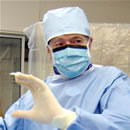
|
March 19, 2008 -- A study of over 30,000 patients that examined every angioplasty done in British Columbia from 1999-2005 was just published online (before print) in the British journal Heart and the conclusion carries an important message for the interventional cardiology community:
These conclusions may give more incentive for expanded use of the radial approach and credence to its advantages, something that interventional cardiologists who practice both femoral and radial approaches have been discussing for years. These advantages include: patient safety, with less bleeding complications, hematomas and possible nerve trauma, as well as patient comfort, allowing patients to sit up, stand and walk immediately after the procedure. The femoral approach requires patients to lie still on their backs for hours to achieve hemostasis. Many of these observations can be read in interviews posted in Angioplasty.Org's Radial Access Center, the most extensive collection of information about the transradial approach on the internet for both patients and professionals.
Although excessive bleeding and blood transfusions after angioplasty have been associated with increased mortality in a number of studies, this Canadian registry analysis, due to its extensive breadth in numbers of patients, is among the first to observe a difference in mortality when comparing the femoral and radial approaches. As the authors state:
The results of this study may have significant implications, especially in the United States. Although the trans-radial approach is used in up to 40% of all procedures done in Europe and Japan, usage in the U.S. is in the low single digits, partly because the radial approach can be more difficult to learn and is not routinely taught in most cardiology fellowships. Other issues, including reimbursement and administrative issues, have hampered the spread of the radial technique in the States. Radial access for angioplasty was developed in the early 1990's, in Canada and The Netherlands, as an alternative "on-ramp" to the body's arterial highway, and it allowed cardiologists to thread catheters, balloons and stents to the heart via the radial artery in the wrist instead of the femoral artery in the leg/groin area. Increasingly, cardiologists are discovering the advantages of the wrist approach, especially in certain patients, such as obese individuals (where femoral access can be complicated) and those who require substantial use of anticoagulation or antithrombotic therapy (IIb/IIIa inhibitors, clopidogrel, and other pharmacologic agents) which are used to prevent thrombus and blood-clotting during and after stenting procedures. Heart centers in the U.S., where the trans-radial technique is utilized extensively, have begun more and more to offer training courses for physicians and cath lab personnel. A recent symposium with hands-on lab experience was held at the Lenox Hill Heart and Vascular Institute of New York where Dr. Howard Cohen uses radial in over 90% of his cases. On April 2, 2008, Dr. Coppola will be offering a free one-day course on the radial technique at St. Vincent's, also in New York. For more information about the transradial approach, visit Angioplasty.Org's Radial Access Center. (Reported on March 19, 2008 by Burt Cohen, Angioplasty.Org) |
